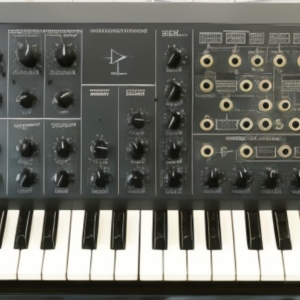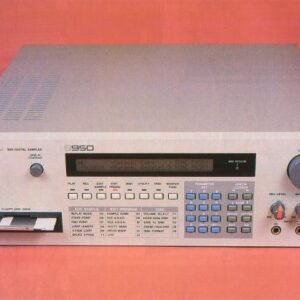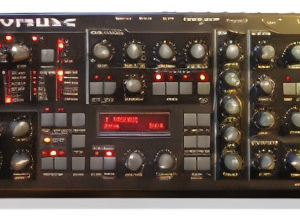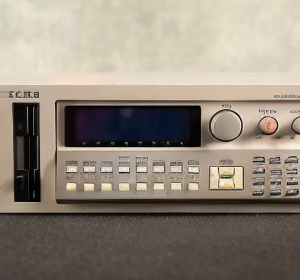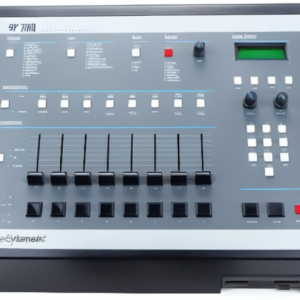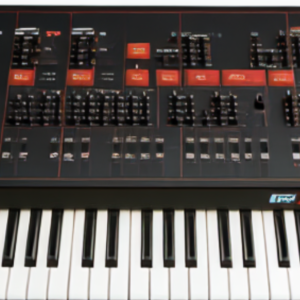Introduction and Background
The Yamaha DX7 stands as a monument in the landscape of synthesizers, recognized for its revolutionary approach to sound synthesis and its profound impact on music production during the 1980s and beyond. Released in 1983, the DX7 was not just another addition to Yamaha’s lineup; it represented a paradigm shift in the world of electronic music.
Before the DX7, synthesizers primarily utilized analog circuitry to generate sounds. These analog synthesizers, while capable of producing a wide array of sounds, were often complex to program and had limitations in terms of replicating acoustic instruments accurately. However, the DX7 changed this narrative by introducing a completely different method of sound generation known as Frequency Modulation (FM) synthesis.
The concept of FM synthesis was not entirely new, as it had been explored in academic and research circles prior to the DX7’s development. However, Yamaha’s implementation of FM synthesis in a commercially available synthesizer was groundbreaking. This technology allowed for the creation of a vast range of complex, dynamic, and realistic sounds that were previously unattainable with analog synthesizers.
The DX7 was the result of Yamaha’s collaboration with engineer John Chowning, who pioneered the theory and application of FM synthesis. Chowning’s research at Stanford University laid the foundation for the development of the DX7, and Yamaha’s engineers refined his concepts into a user-friendly instrument that would revolutionize the music industry.
Upon its release, the Yamaha DX7 quickly became a staple in studios worldwide, embraced by both professional musicians and enthusiasts alike. Its sleek design, intuitive interface, and versatile sound palette made it an instant success. Musicians were drawn to its ability to replicate acoustic instruments with astonishing realism, as well as its capacity for creating futuristic, otherworldly sounds that defined the sound of the 1980s.
The DX7’s impact extended far beyond the realm of synthesizers. Its influence permeated virtually every genre of music, from pop and rock to jazz and electronic dance music. Artists such as Michael Jackson, Prince, Brian Eno, and Chick Corea prominently featured the DX7 in their recordings, contributing to its iconic status and lasting legacy.
In the decades since its release, the Yamaha DX7 has remained a sought-after instrument, cherished by collectors and musicians alike. Its timeless sound continues to inspire new generations of artists, cementing its place in the pantheon of iconic synthesizers. From its humble beginnings as an innovative experiment in sound synthesis to its status as a cultural icon, the Yamaha DX7 remains a testament to the power of innovation and its enduring impact on music history.
Design and Features
The design and features of the Yamaha DX7 set it apart from its predecessors and contemporaries, contributing to its widespread adoption and enduring popularity among musicians. From its sleek exterior to its innovative user interface, the DX7 was designed with both functionality and aesthetics in mind.
At first glance, the DX7’s design may appear minimalist compared to the more elaborate analog synthesizers of its time. Its sleek and understated exterior belies the powerful capabilities housed within. The instrument features a clean layout with a 61-key velocity-sensitive keyboard, providing ample space for expressive playing and performance.
One of the most notable features of the DX7 is its use of Frequency Modulation (FM) synthesis, a departure from the analog synthesis methods prevalent in previous synthesizers. FM synthesis offered a more efficient and flexible approach to sound generation, allowing for the creation of a wide range of tones and textures. This technology was made accessible through the DX7’s intuitive user interface, which simplified the process of programming complex sounds.
The DX7 featured a matrix-style interface that allowed users to easily manipulate various parameters of the sound, such as frequency, amplitude, and modulation depth. This interface, while initially intimidating to some, became a hallmark of the DX7’s design and contributed to its versatility as a sound design tool. With the ability to layer and combine multiple algorithms, users could create intricate and evolving sounds with ease.
In addition to its powerful synthesis engine, the DX7 boasted a variety of built-in effects and processing capabilities, further expanding its sonic palette. From reverb and chorus to pitch modulation and distortion, the DX7 offered a comprehensive array of sound-shaping tools that allowed musicians to sculpt their sound to perfection.
Despite its advanced features, the DX7 was relatively compact and lightweight, making it suitable for both studio and live performance settings. Its robust construction and reliable performance earned it a reputation for durability, ensuring that it could withstand the rigors of professional use.
Overall, the design and features of the Yamaha DX7 were instrumental in shaping its legacy as one of the most influential synthesizers of all time. Its innovative approach to sound synthesis, coupled with its user-friendly interface and versatile capabilities, solidified its status as a must-have instrument for musicians seeking to push the boundaries of sonic exploration.
Sound Generation
The Yamaha DX7 revolutionized the landscape of sound generation with its pioneering use of Frequency Modulation (FM) synthesis. Departing from the traditional analog synthesis methods prevalent in its era, the DX7 introduced a fundamentally different approach that transformed the way musicians created and manipulated sounds.
FM synthesis, developed in part by Stanford University researcher John Chowning and implemented by Yamaha’s engineers in the DX7, relies on the modulation of one waveform (the carrier) by another waveform (the modulator) at varying frequencies. This modulation process creates complex harmonic spectra and timbres, allowing for the synthesis of a wide range of sounds, from rich, bell-like tones to gritty, metallic textures.
One of the key advantages of FM synthesis is its ability to produce highly dynamic and evolving sounds with relative ease. By adjusting parameters such as the frequency ratio, modulation index, and envelope settings, users could sculpt a virtually infinite variety of tones and textures. This versatility made the DX7 well-suited for a diverse range of musical styles and genres, from pop and rock to jazz and electronic music.
The DX7’s sound generation capabilities were further enhanced by its implementation of algorithms, which dictated how operators (the basic building blocks of FM synthesis) interacted with each other to produce complex timbres. The DX7 featured a total of 32 algorithms, each offering a unique configuration of operators and modulation paths. This allowed users to experiment with different sound structures and arrangements, adding depth and dimension to their compositions.
One of the defining characteristics of the DX7’s sound is its ability to accurately replicate acoustic instruments with remarkable realism. From pianos and brass to strings and percussion, the DX7’s FM synthesis engine excelled at capturing the nuances and nuances of traditional instruments, making it a popular choice for musicians seeking authentic sounds in their productions.
In addition to its acoustic emulations, the DX7 was also capable of producing a wide range of synthetic and experimental sounds that pushed the boundaries of conventional music production. Its ability to create otherworldly textures, evolving drones, and intricate soundscapes expanded the sonic possibilities for artists and composers, paving the way for new forms of expression and creativity.
Overall, the Yamaha DX7’s innovative use of FM synthesis revolutionized the way musicians approached sound generation, ushering in a new era of electronic music production. Its dynamic and versatile capabilities, coupled with its ability to faithfully reproduce acoustic instruments and explore new sonic territories, solidified its place as one of the most influential synthesizers of all time.
Notable Users and Influences
The Yamaha DX7’s impact on music cannot be overstated, with its distinct sound shaping countless hit records and shaping the sonic landscape of the 1980s and beyond. Its versatility, coupled with its ability to produce both realistic and innovative sounds, attracted a wide range of musicians from various genres. Here, we explore some of the notable users of the DX7 and its influence on their work.
1. **Brian Eno**: Renowned for his ambient and experimental compositions, Brian Eno embraced the DX7 for its ability to create unique and ethereal textures. His use of the DX7 can be heard on albums such as “Apollo: Atmospheres and Soundtracks,” where it contributes to the album’s immersive sonic landscapes.
2. **Chick Corea**: Jazz fusion pioneer Chick Corea incorporated the DX7 into his arsenal of keyboards, utilizing its versatile sound palette to push the boundaries of traditional jazz. His performances and recordings with the DX7 showcased its ability to blend seamlessly with acoustic instruments while adding a modern twist to his compositions.
3. **Michael Jackson**: The King of Pop himself, Michael Jackson, utilized the DX7’s capabilities on his landmark album “Thriller.” Tracks like “Billie Jean” feature the distinctive bassline created by the DX7’s synthesized bass sounds, adding a futuristic edge to the album’s pop sensibilities.
4. **Prince**: A master of innovation and musical experimentation, Prince embraced the DX7 for its ability to create bold and dynamic sounds. From funky basslines to soaring lead melodies, the DX7 played a prominent role in Prince’s iconic sound, contributing to hits like “Purple Rain” and “When Doves Cry.”
5. **Toto**: The rock band Toto incorporated the DX7’s iconic electric piano sound into their hit song “Africa,” helping to define the track’s lush and atmospheric production. The DX7’s ability to emulate acoustic instruments added depth and richness to Toto’s sound, contributing to the song’s enduring popularity.
6. **Enya**: Known for her ethereal and atmospheric music, Enya utilized the DX7 to create the lush, layered textures that define her sound. The DX7’s ability to produce shimmering pads and haunting melodies perfectly complemented Enya’s vocals, contributing to the dreamlike quality of her compositions.
7. **Depeche Mode**: Synth-pop pioneers Depeche Mode integrated the DX7 into their electronic soundscapes, using its versatile capabilities to create intricate melodies and pulsating rhythms. The DX7’s distinctive timbres became a staple of Depeche Mode’s signature sound, heard on tracks like “Enjoy the Silence” and “Personal Jesus.”
These are just a few examples of the many artists who embraced the Yamaha DX7 and helped to popularize its unique sound. From pop and rock to jazz and electronic music, the DX7’s influence can be heard across a wide range of musical genres, cementing its legacy as one of the most iconic synthesizers of all time.
Impact and Legacy
The Yamaha DX7 left an indelible mark on the world of music, revolutionizing the way sounds were created, recorded, and performed. Its impact reverberated across the music industry and continues to shape modern music production to this day. Here, we explore the profound influence and enduring legacy of the DX7.
1. **Revolutionizing Sound Synthesis**: The introduction of Frequency Modulation (FM) synthesis through the DX7 marked a paradigm shift in sound synthesis technology. Its innovative approach to generating sounds offered unprecedented flexibility and realism, allowing musicians to create a vast array of tones and textures previously unattainable with analog synthesizers.
2. **Shaping the Sound of the 1980s**: The DX7 played a pivotal role in defining the sonic landscape of the 1980s. Its distinctive electric piano, brass, and bass sounds became ubiquitous in popular music, contributing to the iconic sound of the decade. From pop and rock to R&B and electronic music, the DX7’s influence permeated virtually every genre.
3. **Democratizing Music Production**: The DX7’s intuitive interface and affordable price point democratized music production, making advanced sound synthesis accessible to a wider audience. Its user-friendly design and versatile capabilities empowered musicians of all skill levels to explore new sonic territories and unleash their creativity.
4. **Inspiring Innovation**: The DX7’s success inspired a wave of innovation in the field of electronic music technology. Manufacturers raced to develop their own FM synthesizers, leading to a proliferation of new instruments and sound modules that built upon the foundation laid by the DX7. Its impact can be seen in subsequent generations of synthesizers and digital audio workstations, which continue to evolve and push the boundaries of sound design.
5. **Enduring Popularity**: Despite advances in technology and the emergence of new synthesizers, the Yamaha DX7 remains a coveted instrument among musicians and collectors alike. Its timeless sound and iconic design have earned it a permanent place in the pantheon of classic synthesizers, ensuring its relevance and desirability for generations to come.
6. **Cultural Icon**: Beyond its technical achievements, the DX7 has attained cultural significance as a symbol of the 1980s music scene. Its appearance in countless hit records and its association with iconic artists have solidified its status as a cultural icon, evoking nostalgia for an era defined by innovation, experimentation, and sonic exploration.
In conclusion, the Yamaha DX7’s impact and legacy extend far beyond its role as a musical instrument. It represents a transformative moment in the history of music technology, reshaping the way we think about sound and inspiring generations of musicians to push the boundaries of creativity. Its influence continues to resonate throughout the music industry, serving as a testament to the enduring power of innovation and its ability to shape the course of musical history.
Technical Specifications
The Yamaha DX7, renowned for its groundbreaking FM synthesis technology, boasted a range of technical specifications that set it apart from its contemporaries. From its powerful sound engine to its intuitive user interface, the DX7 offered a comprehensive array of features that revolutionized the world of electronic music production. Here, we delve into the technical specifications of this iconic synthesizer:
1. **Sound Engine**: The DX7 utilized Yamaha’s proprietary Frequency Modulation (FM) synthesis technology, which allowed for the creation of complex and dynamic sounds by modulating one waveform with another. This innovative approach to sound generation offered unparalleled versatility and realism, making the DX7 a favorite among musicians seeking expressive and lifelike tones.
2. **Polyphony**: The DX7 featured a maximum polyphony of 16 notes, allowing for rich and layered performances without the risk of voice stealing or note dropout. This generous polyphony was particularly well-suited for creating lush pads, intricate chord progressions, and dense soundscapes.
3. **Operators**: The DX7’s sound engine comprised six operators, each capable of generating a basic waveform such as a sine wave. These operators could be configured and interconnected using algorithms to create complex timbres and textures. With 32 available algorithms to choose from, users had unprecedented flexibility in shaping their sound.
4. **Envelopes**: The DX7 featured six envelope generators (EGs) – one for each operator – which controlled parameters such as amplitude, frequency, and modulation depth over time. This allowed users to shape the dynamics and articulation of their sounds with precision, from sharp percussive attacks to smooth, evolving pads.
5. **LFOs**: Additionally, the DX7 included two low-frequency oscillators (LFOs) that could be used to modulate various parameters of the sound, such as pitch, frequency, and amplitude. This provided further opportunities for shaping and animating sounds, adding movement and depth to performances.
6. **Keyboard**: Equipped with a 61-key velocity-sensitive keyboard, the DX7 offered a responsive and expressive playing experience. Velocity sensitivity allowed for dynamic control over the volume and timbre of each note, enabling nuanced performances and articulations.
7. **Effects**: While the DX7 did not feature built-in effects, its pristine sound quality and flexible synthesis engine made it compatible with external effects processors. This allowed users to further enhance their sounds with reverb, chorus, delay, and other effects, adding depth and dimension to their compositions.
8. **Memory**: The DX7 came equipped with 32 internal memory patches, allowing users to store and recall their favorite sounds with ease. Additionally, cartridge slots were available for expanding the memory capacity, providing virtually unlimited storage for custom patches and presets.
9. **Connectivity**: The DX7 featured a range of connectivity options, including MIDI (Musical Instrument Digital Interface) compatibility for seamless integration with other MIDI-enabled devices such as sequencers, drum machines, and computers. This allowed for precise control over parameters and synchronization of musical elements.
10. **Dimensions and Weight**: Measuring approximately 100 cm in width, 33 cm in depth, and 11 cm in height, the DX7 had a compact and portable design that made it suitable for both studio and live performance settings. Its lightweight construction, weighing around 8 kg, further enhanced its versatility and mobility.
In summary, the Yamaha DX7’s technical specifications encompassed a powerful synthesis engine, comprehensive control options, and robust connectivity, making it a versatile and indispensable tool for musicians, producers, and sound designers alike. Its innovative features and groundbreaking capabilities paved the way for a new era of electronic music production, leaving an enduring legacy that continues to inspire and influence artists to this day.
Performance and Workflow
The Yamaha DX7, renowned for its revolutionary sound generation capabilities, offered a performance and workflow experience that revolutionized electronic music production. From its intuitive interface to its versatile performance features, the DX7 provided musicians with a powerful tool for creating and shaping sounds in real-time. Here, we explore the performance and workflow aspects of this iconic synthesizer:
1. **Intuitive Interface**: Despite its advanced synthesis engine, the DX7 featured an intuitive user interface that simplified the process of sound design and programming. Its matrix-style layout allowed users to visually navigate parameters such as frequency, modulation depth, and envelope settings, making it easy to create and manipulate sounds with precision.
2. **Patch Memory**: The DX7 boasted a comprehensive patch memory system, allowing users to store and recall their favorite sounds with ease. With 32 internal memory slots and support for external cartridge storage, musicians could organize and access a vast library of custom patches and presets for use in performances and recordings.
3. **Real-Time Control**: One of the key features of the DX7 was its ability to provide real-time control over sound parameters during performance. Dedicated knobs and sliders allowed users to adjust parameters such as frequency, modulation depth, and envelope settings on the fly, enabling dynamic and expressive performances.
4. **Velocity Sensitivity**: Equipped with a velocity-sensitive keyboard, the DX7 responded to the nuances of a player’s touch, allowing for expressive and emotive performances. Velocity sensitivity could be used to control parameters such as volume, brightness, and modulation depth, adding depth and realism to performances.
5. **Performance Memory**: In addition to patch memory, the DX7 featured performance memory slots where users could store and recall entire setups, including patch assignments, keyboard splits, and MIDI settings. This allowed for seamless transitions between different sounds and configurations during live performances.
6. **MIDI Integration**: The DX7 was one of the first synthesizers to feature MIDI connectivity, allowing for seamless integration with other MIDI-enabled devices such as sequencers, drum machines, and computers. MIDI communication enabled precise control over parameters and synchronization of musical elements, enhancing the DX7’s versatility and workflow.
7. **Arpeggiator and Sequencer**: Some versions of the DX7 included an arpeggiator and basic sequencer, further expanding its performance capabilities. The arpeggiator allowed users to create intricate melodic patterns and rhythmic sequences, while the sequencer provided basic recording and playback functionality for capturing musical ideas on the fly.
8. **Expandability**: While the DX7 itself offered a comprehensive set of features, users could expand its capabilities further through the use of external accessories and software. MIDI expansion boards, patch editors, and sound libraries were available to enhance the DX7’s functionality and customization options, catering to the diverse needs of musicians and producers.
In summary, the Yamaha DX7’s performance and workflow capabilities were instrumental in shaping its legacy as one of the most iconic synthesizers of all time. Its intuitive interface, real-time control features, and seamless integration with MIDI technology provided musicians with a powerful and versatile tool for creating and performing music in a variety of styles and genres. Whether in the studio or on stage, the DX7 empowered musicians to unleash their creativity and explore new sonic territories with ease and confidence.
Collector's Value and Market Trends
The Yamaha DX7 holds a significant place in the hearts of musicians and collectors alike, with its pioneering FM synthesis technology and iconic sound shaping the landscape of electronic music. As a result, the DX7 has become a sought-after instrument on the vintage synthesizer market, with collectors and enthusiasts eager to acquire and preserve these historic instruments. Here, we delve into the collector’s value and market trends surrounding the Yamaha DX7:
1. **Historical Significance**: The Yamaha DX7 represents a landmark moment in the history of electronic music technology, ushering in a new era of sound synthesis with its revolutionary FM synthesis engine. Its impact on music production and its association with iconic artists and hit records have solidified its status as a cultural and historical artifact, driving up its collector’s value.
2. **Limited Availability**: While the DX7 was produced in relatively large numbers during its production run in the 1980s, finding well-preserved examples in good working condition can be challenging. Many DX7s have suffered from wear and tear over the years, with components such as key contacts, battery holders, and internal circuitry requiring maintenance or replacement.
3. **Rising Demand**: Despite its age, the demand for the Yamaha DX7 remains strong among musicians, producers, and collectors. Its distinctive sound, versatile capabilities, and nostalgic appeal continue to attract interest from a wide range of enthusiasts, contributing to its increasing collector’s value.
4. **Variants and Special Editions**: Over the years, Yamaha released several variants and special editions of the DX7, including the DX7IID, DX7S, and DX7IIFD, each offering additional features and improvements over the original model. These variants, particularly rare or limited-edition versions, command higher prices on the collector’s market due to their scarcity and unique characteristics.
5. **Cosmetic Condition**: The collector’s value of a Yamaha DX7 is heavily influenced by its cosmetic condition, with well-maintained examples fetching higher prices than those showing signs of wear and tear. Instruments with intact keys, clean panels, and minimal scratches or blemishes are generally more desirable to collectors and command premium prices.
6. **Original Accessories and Documentation**: DX7s accompanied by their original accessories, such as power cables, manuals, and cartridges, are highly sought after by collectors. Complete sets with all original documentation and packaging can significantly enhance the collector’s value of the instrument, providing additional authenticity and historical context.
7. **Market Trends**: The vintage synthesizer market fluctuates based on factors such as supply and demand, economic conditions, and cultural trends. While the collector’s value of the Yamaha DX7 has steadily increased in recent years, market trends can vary regionally and are subject to change over time.
In conclusion, the Yamaha DX7 holds significant collector’s value and remains a prized possession for enthusiasts of vintage synthesizers. Its historical significance, limited availability, rising demand, and unique variants contribute to its allure as a collectible instrument. As the vintage synthesizer market continues to evolve, the Yamaha DX7’s status as an iconic and influential instrument ensures its enduring appeal among collectors and musicians alike.
Innovations and Contributions
The Yamaha DX7 stands as a testament to innovation and technological advancement in the realm of electronic music. Its introduction marked a watershed moment in synthesizer history, bringing about significant innovations and contributions that continue to shape the landscape of music production. Here, we explore the key innovations and contributions of the Yamaha DX7:
1. **Frequency Modulation (FM) Synthesis**: Perhaps the most groundbreaking innovation introduced by the Yamaha DX7 was its implementation of Frequency Modulation (FM) synthesis. Developed in part by researcher John Chowning and refined by Yamaha’s engineers, FM synthesis offered a radically different approach to sound generation compared to traditional analog synthesis methods. By modulating one waveform with another at varying frequencies, FM synthesis enabled the creation of complex and dynamic sounds with unparalleled realism and versatility. This revolutionary technology paved the way for a new era of electronic music production, influencing countless musicians, producers, and synthesizer designers.
2. **Versatile Sound Palette**: The Yamaha DX7’s FM synthesis engine offered a vast and versatile sound palette, allowing users to create a wide range of tones and textures that were previously unattainable with analog synthesizers. From realistic emulations of acoustic instruments to futuristic and otherworldly sounds, the DX7 empowered musicians to explore new sonic territories and push the boundaries of creativity. Its distinctive electric piano, brass, and bass sounds became ubiquitous in popular music, shaping the sound of the 1980s and beyond.
3. **User-Friendly Interface**: Despite its advanced synthesis capabilities, the Yamaha DX7 featured an intuitive user interface that simplified the process of sound design and programming. Its matrix-style layout, with parameters organized into rows and columns, allowed users to navigate and manipulate sound parameters with ease. This user-friendly design made the DX7 accessible to musicians of all skill levels, democratizing electronic music production and inspiring a new generation of artists.
4. **MIDI Integration**: The Yamaha DX7 was one of the first synthesizers to feature MIDI (Musical Instrument Digital Interface) connectivity, allowing for seamless integration with other MIDI-enabled devices such as sequencers, drum machines, and computers. MIDI communication enabled precise control over parameters and synchronization of musical elements, enhancing the DX7’s versatility and workflow. This innovation laid the groundwork for modern electronic music production techniques and established MIDI as a standard protocol for musical instrument communication.
5. **Cultural Influence**: Beyond its technical innovations, the Yamaha DX7 had a profound cultural influence, shaping the sound of popular music and defining the aesthetics of the 1980s. Its distinctive timbres and textures became synonymous with the era’s synth-pop, new wave, and electronic music movements, influencing countless artists and producers. The DX7’s impact can be heard in hit records across a wide range of genres, cementing its legacy as one of the most iconic synthesizers of all time.
In summary, the Yamaha DX7’s innovations and contributions to electronic music technology are immeasurable. From its groundbreaking FM synthesis engine to its user-friendly interface and cultural influence, the DX7 revolutionized the way sounds were created, recorded, and performed. Its legacy continues to resonate in modern music production, serving as a source of inspiration and innovation for generations of musicians, producers, and synthesizer enthusiasts.
Community and Support
The Yamaha DX7 not only revolutionized electronic music production with its innovative technology but also fostered a vibrant community of musicians, producers, and enthusiasts who share a passion for this iconic synthesizer. This community has played a crucial role in providing support, sharing knowledge, and celebrating the legacy of the DX7. Here, we explore the community and support surrounding the Yamaha DX7:
1. **Online Forums and Communities**: The DX7 community thrives on various online forums, social media platforms, and dedicated websites where enthusiasts gather to discuss all aspects of the synthesizer. These forums serve as valuable resources for troubleshooting technical issues, sharing tips and tricks, exchanging patch libraries, and connecting with like-minded individuals who share a love for the DX7.
2. **User Groups and Meetups**: In addition to online communities, DX7 users often organize local user groups and meetups where they can network, share experiences, and collaborate on music projects. These gatherings provide opportunities for hands-on demonstrations, workshops, and performances, fostering a sense of camaraderie and collaboration among DX7 enthusiasts.
3. **Patch Libraries and Resources**: The DX7 community has curated extensive patch libraries and resources containing thousands of user-created patches, presets, and sound banks. These libraries offer a treasure trove of sonic inspiration and serve as valuable tools for musicians seeking to expand their sonic palette or recreate classic sounds from iconic recordings.
4. **Technical Support and Maintenance**: Despite its age, the DX7 remains a reliable and robust instrument, thanks in part to the dedicated community of enthusiasts who provide technical support and maintenance resources. From troubleshooting common issues to repairing and restoring vintage units, DX7 enthusiasts offer valuable expertise and guidance to ensure the longevity of these iconic synthesizers.
5. **Educational Content and Tutorials**: The DX7 community produces a wealth of educational content and tutorials covering various aspects of sound design, programming, and performance techniques. From beginner’s guides to advanced tutorials, these resources empower users to unlock the full potential of their DX7 and explore new creative possibilities.
6. **Collaborative Projects and Remix Contests**: DX7 enthusiasts often collaborate on collaborative music projects, remix contests, and composition challenges that showcase the versatility and creativity of the synthesizer. These projects encourage experimentation, innovation, and collaboration within the community, fostering a dynamic and supportive environment for musical exploration.
7. **Manufacturer Support and Legacy**: While Yamaha no longer produces the DX7, the company continues to offer support for owners of vintage DX7 synthesizers through its customer service channels and online resources. Additionally, Yamaha has released updated versions of the DX7’s FM synthesis engine in modern synthesizers and software instruments, ensuring that the legacy of the DX7 lives on in new generations of musicians and producers.
In summary, the Yamaha DX7 community is a testament to the enduring legacy and cultural impact of this iconic synthesizer. Through online forums, user groups, patch libraries, educational content, and collaborative projects, enthusiasts come together to celebrate the DX7’s rich history, share knowledge and expertise, and inspire creativity and innovation in electronic music production. Whether connecting with fellow enthusiasts, seeking technical support, or discovering new sounds, the DX7 community continues to play a vital role in preserving and perpetuating the legacy of this legendary synthesizer.

